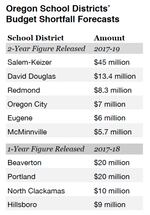School districts across Oregon are warning of potentially deep budget cuts if legislators don’t find additional money for public schools.
But the anticipated gaps are largely a result of rising costs, rather than a decline in state revenue, leading to different opinions of the budget picture.
Gov. Kate Brown has characterized her recommended budget as flat spending, saying "the total state school fund supports current levels of service."
Related: Advocates Urge Oregon Lawmakers To Find Money For Voter-Approved Measure 98
Oregon’s three largest school districts — Beaverton, Portland and Salem-Keizer — foresee cuts of at least $20 million a year, if legislators pass a budget at Brown’s recommended level.
More than 60 districts from Coos Bay to Umatilla have created budget posters with the help of school boards, administrators and union groups as part of the Oregon Rising coalition. The multi-color posters propose higher funding levels that school advocates would like to see.
The budget posters also show where school districts are considering cuts. (Find the budget posters on the Oregon Rising website).
Salem-Keizer is anticipating a $45 million shortfall over the two upcoming school years. The district suggests five different ways it could cut the budget, including the reduction or elimination of instructional coaches; cuts to textbooks, technology and transportation; and reducing "our ability to adequately maintain schools and buildings."
Beaverton and Portland are each forecasting $20 million in cuts for the upcoming school year — meaning a two-year cut that would be similar to Salem-Keizer's. Both districts anticipate larger class sizes. Portland also warns of delays to two scheduled improvements: compliance with Oregon's physical education mandate and a new literacy curriculum adoption.
Elsewhere, North Clackamas is looking at a $10 million cut in the upcoming school year. Officials say that equates to eliminating 100 teaching positions or canceling almost four weeks of school.

The above table looks at the budget cuts anticipated by the 10 largest Oregon schools districts that reported potential shortfalls.
OPB
The Hillsboro district foresees a $9 million cut, and potentially big increases to class sizes or a significantly shorter school year.
Other districts, like Canby and Tigard-Tualatin are not sounding budget alarms, but are taking more of a wait-and-see approach instead.
"We are working with a community committee on a strategic financial plan that outlines spending priorities," said Tigard-Tualatin spokeswoman Susan Stark-Haydon. "Once that work is completed, we will be sharing the plan with the community along with the impact state funding levels may have on our ability to accomplish the priorities within the plan."
School districts are in the budget-writing process.
Regardless of the eventual spending level, passing a budget can be particularly difficult, without knowing what legislators will ultimately approve for the state's public schools.
